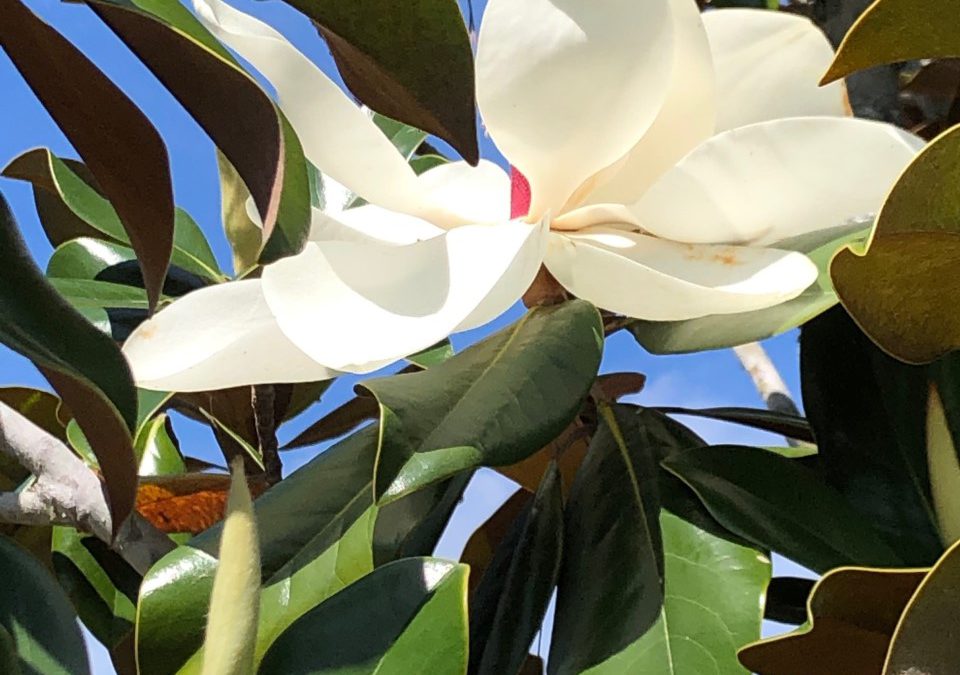
by Stephen Greer | Apr 15, 2021
There is a tall stately tree that can be found throughout the southeastern states, native in nature with a lustrous green leaf the southern magnolia is like no other tree. This amazing tree can be found from the edge of deep woodlands to the back of the tall sand dunes in the panhandle of Florida, all the way down the Florida Peninsula. The leaves provide a consistent evergreen providing a year-round presence in the landscape. Spring brings up small plate sized creamy white blooms with a wonderful fragrance with multiple blooms opening over 3 to 5 weeks. The magnolia can serve as a specimen tree or a back drop to allow other plants to be enjoyed.
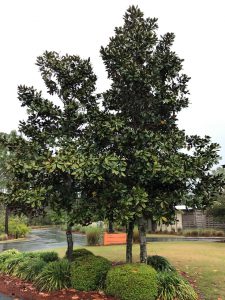
Magnolia Tree in the Landscape. Photo courtesy Stephen Greer
Often the magnolia is envisioned to be this 80-foot tall by 40-foot-wide tree with an upright pyramidal shape with the branches reaching to the ground and up to 8-inch-long shiny green leaves. There are other shapes and sizes in the landscape industry that have been found in many different ways from seedling research that has taken place at several of our land grant universities including the University of Florida. Other magnolia with different growth and bloom habits have been found growing in nature. Below are a few of these exceptional species that were selected by the keen eye of a nurseryman or a plant specialist. Next come decades of field grown observation to determine if the plant characteristics are consistent with cuttings taken and rooted to grow more trees. This is one way to see if the same look and growth continues in multiple plants.
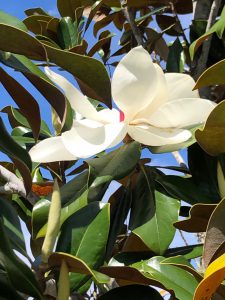
Magnolia Bloom. Photo courtesy Stephen Greer
If you grow trees from collected seeds, the new seedlings will show variable growth patterns and likely not present a consistent growth or leaf form from tree to tree. This is the reason for taking cuttings from a magnolia with the desired growth habit, leaf size and color, bloom color and fragrance.
Several cultivars have risen to the top in popularity in the landscape industry over the last 30 to 40 years. One of the most popular large magnolias is ‘Bracken’s Brown Beauty’. It was selected in a seedling field when one of the universities had completed research and invited a local nurseryman to come take any he wanted before the field was turned under for other plant research. Many were dug and field planted at the nursery with one showing many desired characteristics. With its dark rusty brown lower leaf and deep green top. It was observed for a number of years with cuttings taken. One major observation was its tolerance to cold weather. They had a winner and began to introduce it into the plant industry. ‘Little Gem’ is another magnolia that is quite popular for its dwarf (slower) upright growth habit. It first was considered a hedge plant with a dense leaf canopy from bottom to top. The challenge is the plant density opens up as it matures with it ultimately reaching approximately 30-foot tall by 20-foot wide. The surprising part of this smaller magnolia is its bloom is similar in number, yet 3 to 5 inches in size in large numbers as the other southern magnolias. Next there is a few weeks rest period and then sporadically blooms all summer and early fall. There are so many magnolias that could be mentioned I just don’t have enough article space, so it will stop with ‘Claudia Wannamaker’. This magnolia is an old stand by that has been found to be moderately salt tolerant and can be found growing near coastal settings. The leaf wax layer is slightly thicker allowing for a little more protection from the salt. It has a more open multi-truck growth allowing for wind to pass through more easily. The challenge is finding one in the landscape industry.
Contact your UF IFAS Extension office in your county with questions. Enjoy this wonderfully unique tree.
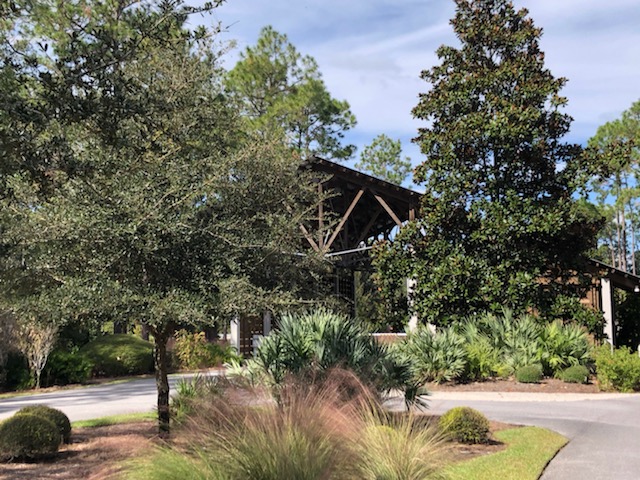
by Stephen Greer | Mar 11, 2021
Landscaping with native plants brings opportunities and challenges while adding diversity and beauty to the home. There are many factors that come into play to successfully grow plants. As gardeners, we all want things to look exceptional for all to enjoy. Native plants have evolved over long periods of time naturally in a given region without intervention, bringing much needed diversity to natural areas and landscapes. A big plus for natives are the flowers presented for the local bee populations and other pollinators assisting in the continuation of the plant species potentially established over thousands of years.
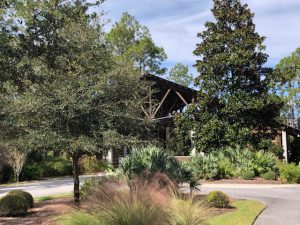
Landscape of Native Plants. Photo Credit: Stephen Greer, UF IFAS Extension Santa Rosa County
Native plants have evolved in natural communities and are found to be interdependent not only plant to plant yet with soil type, soil microbial activity through bacteria and fungus, specific site location and others though biodiversity of these living communities. Part of this community is often referred to as the soil web creating the connections of billions upon billions of organisms in the critical survival of the plants, insects and other animals we see. The first steps when considering native plants for your landscape are to do your research and contact your local Extension office. Some questions to consider may include: Does it grow best in well drained sand or wet soils or require high in organic matter? Will full sun, part-shade to full shade be needed?
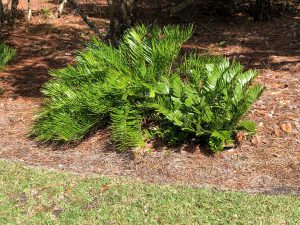
Coontie Palm in Landscape. Photo Credit: Stephen Greer, UF IFAS Extension Santa Rosa
Plants that are native and non-native are often seen in the same landscape setting. Consideration should be taken to determine if either of the groups are aggressive in expanding beyond the intended plant setting. Before moving on, non-native is in reference to plants that are introduced to a plant community that came from a totally different plant location. An example of that location being hollies from southeast Asia or South America or even a different area of the United States. Many have been researched and observed for many years under managed situations before being introduced into the local landscape nursery markets. Once in a while a plant is introduced that has not gone through a long rigorous study and can become naturalized outside of its normal plant zones and establish as an invasive species. This highly adaptable aggressive habit can, and often will colonize a given location out competing the native plants. Kudzu is a good example of an invasive exotic plant that is naturalized in the southeastern U.S.
As gardeners there are opportunities to have positive impacts on some of these diminished native habitat areas that can be threatened by growth of urban and rural areas in Florida. Establishing native plants areas into the landscape with proper soil preparation, managed water needs and more gives that chance for this interdependent system of plants, animals and nonliving elements to remain established with big impacts.
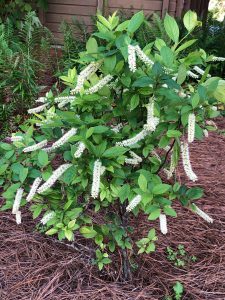
Virginia Sweetspire. Photo Credit: Stephen Greer, UF IFAS Extension Santa Rosa County
Native plants can be a working part of the garden from wonderful flowers, season color change, leaf foliage of multiple sizes and shapes to feed the insects that feed the birds, leaves and nuts that feed so many other animals for us to enjoy seeing. Balance is such a big part of being a successful gardener. Remember not all native plants are suitable for landscape spaces, do your research and ask for assistance from the experts to determine if it is the right plant for the right place.

by Stephen Greer | Nov 13, 2020
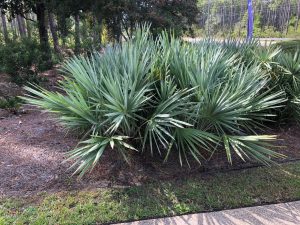
Photo credit: Stephen Greer, University of Florida/IFAS Extension
Landscapes are an ever-changing setting that can be fun to view as the seasons come and go. We all have differing ideas of what an exceptional landscape should be. The point to always keep in mind is what you and your family like. Are you considering the Florida-Friendly Landscaping elements? You always want to keep a healthy, attractive environmental sound landscape. This brings many interesting design concepts to the table.
The kitchen table is exactly where a landscape design needs to begin. My dad was just the opposite, he would receive or buy plants on impulse. Load up all these three-gallon plants, take them home and plant without consideration the long-term growth, color combinations, time of bloom and many more topics. He just loved working in the yard and growing plants.

Photo Credit: Stephen Greer, University of Florida/IFAS Extension
There are basic principles of landscape design that are used as a guide. While I may stray from them from time to time, I always return to these principles. Just keep in mind that a landscape is an ever-changing living setting that we will always work to improve. The visual elements are based on what you see first when you enter a setting and are usually the vibrant high impact plants that may include bright bloom color, size of plant, focal plantings, leaf size and others. The other side of the visual is the subtle presence of low impact plants with softer colors, small leaves, lower growing plant size. This visual group often is planted en mass with a flow of plants to create a calming effect for the visitors to your landscape.
When the form of the plant is being considered, there are several points to keep in mind. Will it have a three-dimensional impact in the landscape setting? Is the landscape a small backyard or a one-acre open setting? What are the maintenance requirements of the plant(s) as they mature in size? A large tree can dominate a small area, but it may be just what is needed for shade with low plantings around it. In a large setting, multiple large trees may be needed to create a focal point. I have seen some wonderful tree alleys that help in directing the flow of the landscape down drives, walks, and paths. These forms should be considered for all plants in the landscape including, trees, shrubs, groundcovers and even hardscapes.
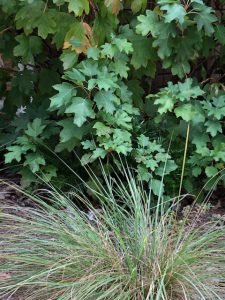
Photo Credit: Stephen Greer, University of Florida/IFAS Extension
Up next is the texture of the plant(s). Are you looking for large and coarse or small, “softer” leaves? You may find finely textured plants along paths or at entry areas to steps, softening the hardscape of the steps. Are the large leaved plants open and airy, allowing light to flow through? Large coarse leaved plants may be found at the back of landscape beds with fine textured smaller plants in front creating a three-dimensional look or even used as a focal point to pull the gaze of the eye to a determined location.
Color in the landscape has just as much impact as the plant texture, size and form. Color can bring a bold or a soft statement. The color is often thought of from blooms, but leaves too change in color with the seasons, from a fresh new bright green, purple, red or other colors in the spring to deeper, more mature colors as summer comes in. Trunks can also bring unique colors to the landscape from subtle yellows to cinnamon.
There are so many things to think about when creating a long-term vision for your landscape. Many options come in the decisions that will need to be made. Do your research and always contact your local Extension office for more information!
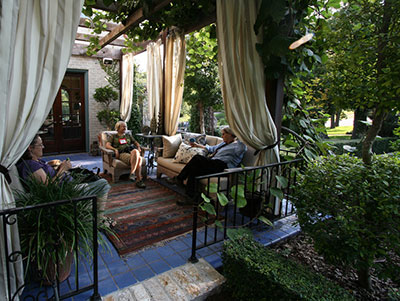
by Stephen Greer | Oct 1, 2020
Living in Northwest Florida brings many wonderful opportunities to be outside enjoying all the things nature has to offer. Outdoor living can become an extension of your home life. Planning and placing a creatively planned landscape space to be a part of this outdoor living adds so many dimensions for all to enjoy.

Outdoor Living, Courtesy UF / IFAS Gardening Solutions page.
Creating a relaxing space outside of your home needs to take in many considerations before planning begins. These spaces should take into account the creative thoughts of the homeowner. Do you enjoy grilling, sitting quietly to take in the sights and sounds of nature, gardening, hedges and walls for private areas, enjoying shady or sunny spots and many other considerations? Do you most like spending your time outside during the day or evening? Will lighting be needed? How much space do you have? What types of furniture will be selected to create those small sitting spots?
Soil types around your home should be a part of plant selections and include water movement considerations during the design process. The northwest area of Florida ranges from sandy coastal to sandhill sands to clay soils in the northern area of many panhandle counties. It is recommended to take soil samples to determine soil needs prior to placing the first plant into these outdoor spaces. With soil moisture ranging from wet to dry, certain plants perform well in wet sites and others in dry sites. That information should be a part of landscape planning decisions.
How do you envision these enjoyable areas and link to the home design? Flowing from the front entry through the home out to the backyard, you need to keep in mind what you and your family want to see and enjoy. What will it look like as the settings mature and change? Will there be walkways connecting the outdoor rooms. What types of walk materials will be used, stone, gravel, wood, turfgrass or another creative material? Are specific plant settings desired that may include a vegetable, flower or herb garden?
Mitigating the influence of insect pests needs to be a consideration when creating an outdoor living space in the panhandle.
Building a fire wise landscape is an important consideration also as the risk of wildfire in the state is always present during drought periods. Selection of plants that are fire resistant should be a priority. Enjoying time with family around the firepit is a pleasant experience. Keep in mind to plan, place and use firepits wisely. Have a firepit safety plan ready.
Outdoor living spaces also include recreation areas, both on and off your property. We are fortunate to have bike friendly roadways, especially in quiet neighborhoods. When biking, always follow the rules and regulations of the road. While out enjoying your pedaling adventure, you may want to take along the fishing equipment. If these are part of your plans think about storing supplies in locations with easy access.
There are a lot of questions that will need to be addressed before outdoor living spaces are created. One important consideration: outdoor spaces should be a comfortable place to visit and may be a quiet place for contemplation or a fun setting for friends and family. Thought should be given to hiring a professional landscape company to assist in making these wonderful settings a reality. Enjoy your outdoor living space!
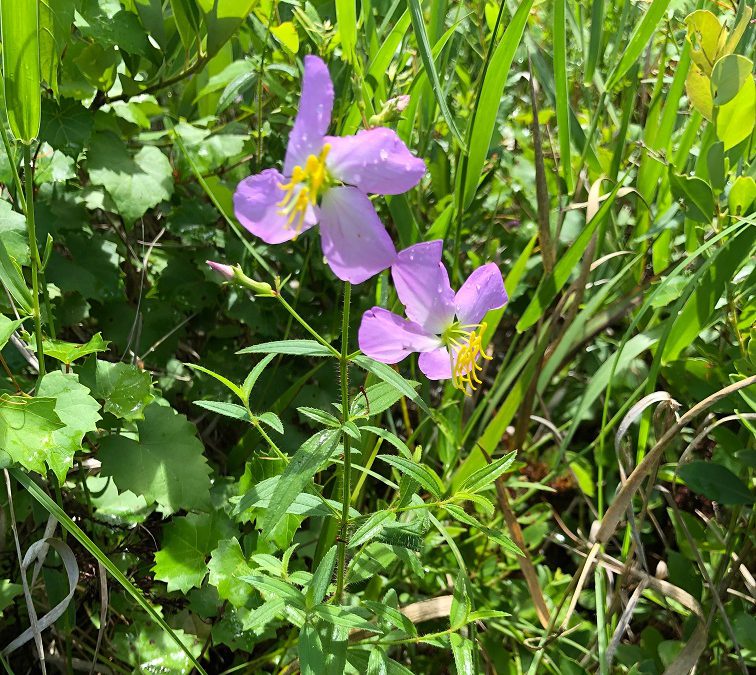
by Stephen Greer | Jul 16, 2020
By: Stephen Greer, CED Santa Rosa County
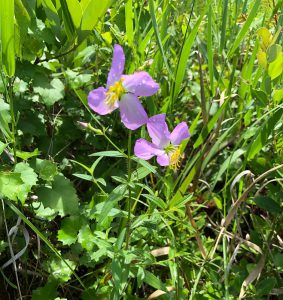
Rhexia marianna Photo credit: Stephen Greer, University of Florid IFAS
There is a lot to be said about early morning or late afternoon walks along a woodland trail in Northwest Florida. With so much to see, hear and smell there is never enough time to take it all in. I would suggest slowing down and look for the many colorful and interesting plants these native plant communities have to offer.
I had the great fortune to meet with a group of plant explores lead by Angus Gholson, botanist and conservationist with a passion to share his knowledge in Washington County many years ago for a 5-hour hiking adventure. We hiked an exceptional longleaf pine forest with immense flora on the forest floor. It was all but impossible to see everything.
We searched for unique and common plants in the Sandhills and Clayhills in the central and northern areas of Washington County. Here are just a few of the plants we saw along our hike and some detail about them.
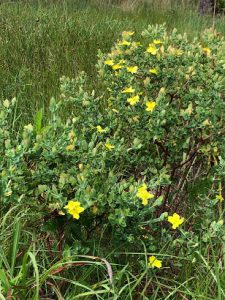
St. Peter’s-wort. Photo create: Stephen Greer University of Florida IFAS
St. Peter’s-wort, Hypericum tetapetalum is a wonderful Hypericum of the many we have in NW Florida. With its ability to repeat bloom petite yellow flowers from March to November, we often get the chance to revisit these trails at a later date for another chance to enjoy them. Like many repeat blooming natives, there will be weeks of rest periods with no bloom. This shrub will grow to three feet tall allowing the flowers to peak out over other plants in the pine flatwoods.
Shiny Lyonia, Lyonia lucida is another exceptional shrub with many uses. This evergreen can grow in low damp areas or with irrigation in landscapes to 10 to 12 feet tall. When found in pine forest areas they range from 3 – 6 feet tall. This Lyonia produces an attractive small bell-shaped red flower spread across a stem of last years growth similar to blueberry. Flowering can occur between November and June.
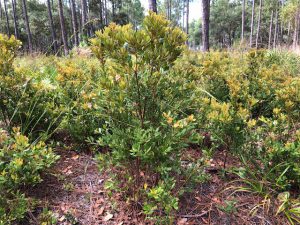
Lyonia lucida. Photo credit: Stephen Greer, University of Florid IFAS
Pale Meadow Beauty, Rhexia Marianna brings a soft pink bloom to the pine forest, grass prairies and edge of full sun to part-shade wetlands. With the ability to grow in diverse landscapes in Northwest Florida it can just about show up anywhere, bloom a few weeks and melt back into the natural setting. Seeding is best completed in the fall and consistent moisture is needed for bloom to occur.
All three of the plants in this article can be found at native plant nurseries. Call the nursery well ahead of time to make sure they either have it or can order it for you. Enjoy the outdoors and adventure it has to offer.

















